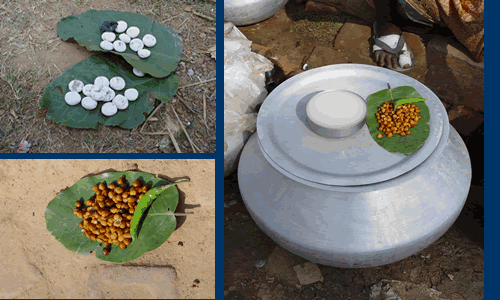|
Get
your onions knocked
by this home-brewed beer 
Rice,
herbs, loads of sunshine and some hay. Together they look like provisions for
a saint. But don't conclude yet, together they can also concoct themselves into
handiya, or rice beer, which is the great unifier in Jharkhand. Everybody loves
handiya, some for its nutrition, others to get high. If you are in mood for it,
you don't need to go walk too far from your home, for under every tree sits a
woman selling handiya in aluminum or plastic containers.
Handiya:
Rice, herbs, loads of sunshine and some hay. Together they look like provisions
for a saint. But don't conclude yet, together they can also concoct themselves
into handiya, or rice beer, which is the great unifier in Jharkhand. Everybody
loves handiya, some for its nutrition, others to get high. If you are in mood
for it, you don't need to go walk too far from your home, for under every tree
sits a woman selling handiya in aluminum or plastic containers. Okay, forgive
the exaggeration, they don't sit under every tree, but they are never too far.
A traditional drink, handiya's basic ingredient is rice. Not just any rice.
It has to be a special kind of brown rice, which over the years has come to be
known as handiya rice. Avoid the pressure cooker, cook rice in a huge utensil
with enough water to make it really soft. Let it cool.
Thinking you can
brew it at home, sounds that simple? No, you can't, because nobody shares the
secret herbs that make ranu; it is the pebble-sized ranus that make you tipple.
Ranus are made of polished rice, embellished with 21 herbs and dried for four
days. Three ranus are enough to add passion to one kg of rice.After
ranu is added to the cooked rice, it is left to ferment for nearly four-five days
in summer and eight-nine days in winter. To add warmth and rev up fermentation,
aluminum pots that contain handiya are covered with hay in winter. Though rice
beer is sweet, sugar is never added to it. The secret herbs in the ranus give
handiya that faint sweetness. Once ready,
handiya is sold in local haat for anywhere between Rs 2 and 2.50 for a bowl. A
typical beer bottle full of rice beer comes with a Rs 5 tag. It is always served
with either sprouted or roasted chana (gram). If you look at the economics of
it, 16 kg of uncooked rice that is turned into handiya can get fetch Rs 250- Rs
300. A similar drink is made out of mahua
and called chulaya. But selling mahua handiya is illegal unless you have a permit.
A bottle of handiya in the morning and one
in the evening keeps the doctor away. At least that is what all handiya lovers
would have you believe. They say it keeps the stomach cool and wards off all ailments,
specially jaundice. But men sozzled with handiya and swaying like leaves in a
breeze are not an uncommon sight in Jharkhand. Point that to a handiya lover and
they would repeat the adage excess of anything is bad. They vouch they drink it
for health. And to health.
Dhuska:
If one were to look for cousins of dhuska, dosa could be a remote one. For the
basic ingredients remain the same, though dhuska looks and tastes very different
from a traditional dosa. Take two cups of rice and one cup of urad dal. Soak it
overnight, add salt and turn it into a thick paste in a mixer-blender. Pour it
in a container, cover the mouth of the container with a light cotton cloth and
leave it in the sun to ferment. A couple of hours in the sun give the basic ingredient
its sourness and pungency.
Heat mustard oil in a wok and pour a ladleful of
dhuska batter in smoking oil. Deep fry, wait for it to turn brown and then flip
it over. Don't fret if it sticks to the bottom of the wok, it would turn out fine.
Eat really hot with watery potato curry. No, it does not go with thick gravy,
so add loads of water in the potato curry. If you are a meat-eater, try it with
mutton curry, which is a special Holi delicacy. Gulgula:
If dhuska is dosa's country cousin, gulgula could trace its lineage to an ordinary
pakora, though gulgula is always sweet. Boil jaggery or gur, let it cool down
and then add wheat flour to give it the density of a pakora batter. Deep fry it
and have it cold or hot.
In the local haat, you can get six gulgulas for a
rupee and people love it as an accompaniment with tea. High tea, with a sweet
difference!
Published in Discover India
magazine, March 2004. |

